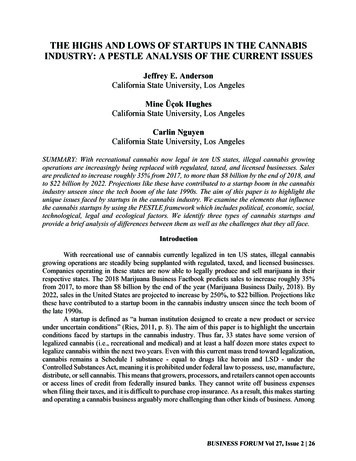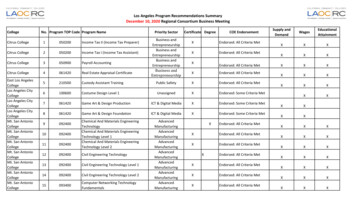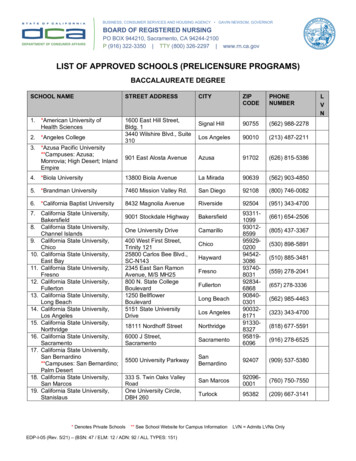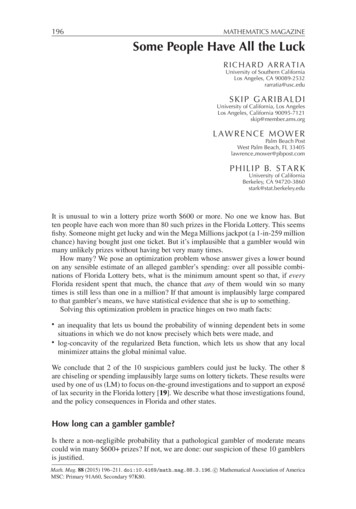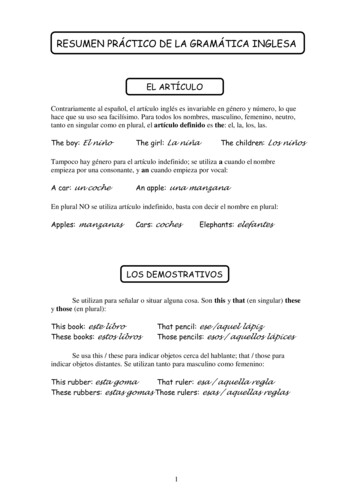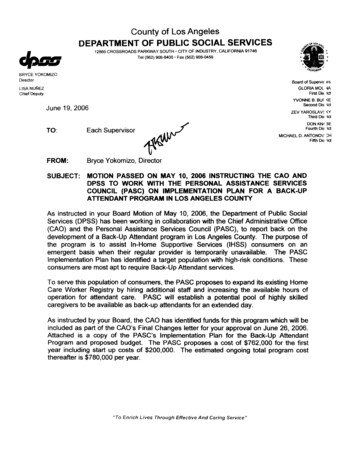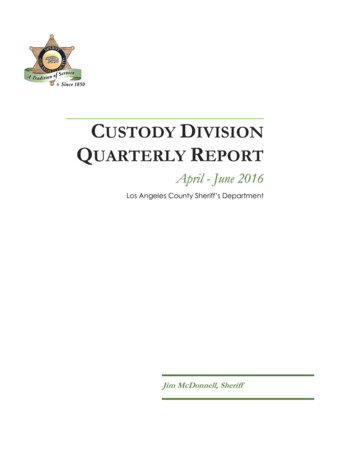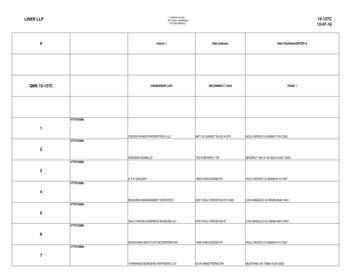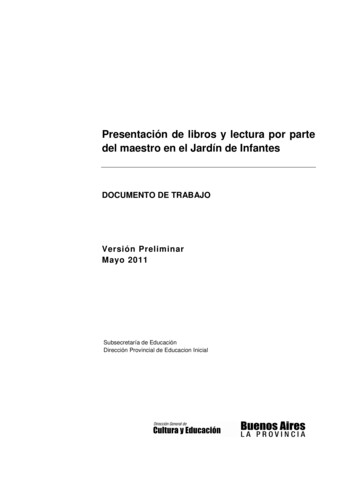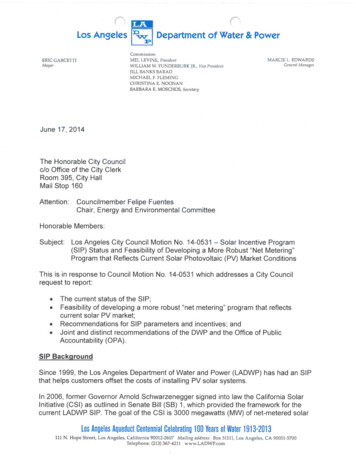
Transcription
LALos AngeleswDepartment of Water & PowerCommissionMEL LEVINE, PresidentWILLIAM W. FUNDERBURK JR., Vice PresidentJILL BANKS BARADMICHAEL F. FLEMINGCHRISTINA E. NOONANBARBARA E. MOSCHOS, SecretaryERIC GARCETTIMayorMARCIE L. EDWARDSGeneral ManagerJune 17, 2014The Honorable City Councilc/o Office of the City ClerkRoom 395, City HallMail Stop 160Attention:Councilmember Felipe FuentesChair, Energy and Environmental CommitteeHonorable Members:Subject: Los Angeles City Council Motion No. 14-0531 — Solar Incentive Program(SIP) Status and Feasibility of Developing a More Robust "Net Metering"Program that Reflects Current Solar Photovoltaic (PV) Market ConditionsThis is in response to Council Motion No. 14-0531 which addresses a City Councilrequest to report: The current status of the SIP;Feasibility of developing a more robust "net metering" program that reflectscurrent solar PV market;Recommendations for SIP parameters and incentives; andJoint and distinct recommendations of the DWP and the Office of PublicAccountability (OPA).SIP BackgroundSince 1999, the Los Angeles Department of Water and Power (LADWP) has had an SIPthat helps customers offset the costs of installing PV solar systems.In 2006, former Governor Arnold Schwarzenegger signed into law the California SolarInitiative (CSI) as outlined in Senate Bill (SB) 1, which provided the framework for thecurrent LADWP SIP. The goal of the CSI is 3000 megawatts (MW) of net-metered solarLos Angeles Aqueduct Centennial Celebrating 100 Years of Water 1913-2013111 N. Hope Street, Los Angeles, California 90012-2607 Mailing address: Box 51111, Los Angeles, CA 90051-5700Telephone: (213) 367-4211 www.LADWP.com
The Honorable City CouncilPage 2June 17, 2014energy systems over 10 years with expenditures not to exceed 3,350,800,000 and withexpenditures for local publicly owned electric utilities not to exceed 784 million. TheLADWP cap is 313 million based on its serving 39.9 percent of the municipal load inCalifornia, representing 280 MW of the 3000 MW goal. Out of the 313 million, 288 million is for solar incentives and the remaining 25 million is for outreach andadministration of the SIP.SIP StatusFigure 1 below shows a summary of the status of the LADWP SIP from 1999 throughApril 30, 2014.FIGURE 1: Status of LADWP Solar Incentive Program 1999 through April 30, 2014Incentives Paid ( 000s)Fiscal Year# of 820.302013/April 30, 20142,18813.8315,10312,078I 103.28 I 239,550 I1999 — April 30, 2014 IThe SIP reflects the current solar PV market. It was designed with steps of decreases inincentive levels to correspond to the anticipated decreases in solar installation coststhroughout the life of the program. Figure 2 on the next page shows how the LADWPsolar incentives have decreased along with the decreased costs of solar installations.Figure 2 also shows that the installed costs to customers after incentives has remainedfairly constant (shown in green).
The Honorable City CouncilPage 3June 17, 2014FIGURE 2Customer Solar Installation Costs by FY ( /Watt AC)12.010.08.06.0A .4.02.00.0FY 2007/08 FY 2008/09 FY 2009/10 FY 2010/11 FY 2011/12 FY 2012/13 FY 2013/14Fiscal Year14 Installed Costafter Incentive /Wit Incentive Cost /WLADWP closely monitors the cost of solar system installations in order to adjust its solarincentive levels. In 2007, LADWP initially offered a solar incentive level (approximately 4.28/W) much higher than other utilities ( 2.80/W) due to LADWP's energy rates beinglower than other utilities.As the cost of solar installations dropped dramatically, LADWP twice received approvalfrom the Board of Water and Power Commissioners (Board) to reduce the incentiverates much faster than the original plans set forth in 2007. In September 2011, LADWPreduced the incentive rate for residential systems by 1.04/W ( 3.24/W to 2.20/W),and for non-residential systems by 0.32/W ( 2.27/W to 1.95/W). In July 2013,LADWP dropped incentive rates by another 0.35/W for both residential and nonresidential installations. At these current levels LADWP is still seeing strong demand forthe SIP; see Figure 3 on the next page which shows the monthly incoming solarincentive applications since May 2008.LADWP's SIP, as governed by SB1, will cease accepting incentive applications onDecember 31, 2016, or when the 288 million in incentive payments is reached,whichever occurs first.By participating in the SIP, customers automatically participate in the Net MeterProgram and, therefore, receive the Net Energy Metering (NEM) rate benefits. Whenthe SIP ends in 2016, LADWP will continue to inspect solar systems and install netmeters for customers who wish to be connected to LADWP's grid. The program will thenbe called a pure Net Metering Program rather than a Solar Incentive Program/NetMetering Program. Through the SIP and the Net Metering Program, LADWP plans toreach a goal of 310 MW by 2019.
The Honorable City CouncilPage 4June 17, 2014Renewable Energy Credits (RECs) from the SIP are classified as Portfolio ContentCategory (PCC) 3 per the California Energy Commission's regulations implementing theCalifornia Renewable Energy Resources Act effective December 10, 2011; only 10percent of LADWP's renewable portfolio may be in PCC 3. The current SIP/NetMetering Program would fully exhaust this limit. Instead of acquiring RECs from SIP/NetMetering Program beyond 310 MW, it is prudent for LADWP to purchase RECs from theLADWP Feed-in Tariff Program — where the energy is bundled with the RECs and areclassified at PCC 1 (valued typically 10 times higher than PCC 3 RECs). The 310 MWamount represents 5 percent of LADWP's expected peak load. The Public UtilityCommission (PUC) limits Investor Owned utilities' Net Metering Program to 5 percent inorder to limit the financial impact on all non-Net Metered ratepayers. Net MeteredResidential customers who offset their entire electrical load pass all fixed electricalinfrastructure cost to other ratepayers.FIGURE 3Monthly Incoming Applications70060050000c*1-7; 400U 15.0. 4- 30004t12001000111111111111ocr,I
The Honorable City CouncilPage 5June 17, 2014Recommendation for the Current 310 MW SIP/Net MeteringTo keep the SIP/Net Metering Program robust, staff recommends that the solarincentives and parameters maintain its designed course based on the following: LADWP solar incentives are set to drop along with solar installation costprojections. The historical drop in LADWP solar incentives is similar to drops in otherstate/utility incentive programs. The LADWP SIP/Net Metering Program continues to see robust participation. LADWP must limit PCC 3 REC purchases at the 310 MW level to comply withRPS requirements and be consistent with PUC rulings.Necessary Changes for Net Metering to Expand Beyond 310 MWAn expanded Net Metering Program may have many benefits for achieving RPScompliance that should be evaluated. However, there are some key policy issuesthat need to be addressed. RECs from Net Metering will need to be classified as PCC 1 by the CaliforniaEnergy Commission rather than its current PCC 3 classification. There is no limitto the amount of PCC 1 RECs that can be applied for RPS compliance. Reformation of residential rates is needed to accurately reflect the true cost ofutility service. Current electric residential rates will need to be 'unbundled' toreflect energy generation, distribution, and transmission costs associated withproviding service. Currently, residential Net Metered customers receive full retailrate (including energy generation, distribution, and transmission components) billcredit for the excess 'green' energy generation they export to the grid during theday. By unbundling the electric residential rate — credit for the 'green' energygeneration component from the Net Metering can be given in an appropriatemanner. This will ensure utility cost for servicing Net Metered customers is notshifted to non-Net Metered customers. An expanded Net Metering Program should have compatible pricing as otheralternatives for local solar development such as Feed-in Tariff. LADWPrecommends studying the costs and benefits of expanding Net Metering Programas compared to other alternatives to provide customers with more businessoptions to further promote local solar. LADWP has discussed this report with the Office of Public Accountability (OPA) in orderto understand and address each agency's perspectives. This report only representsLADWP's viewpoint and respects the OPA's need for independence.
The Honorable City CouncilPage 6June 17, 2014If you have any questions or if further information is required, please call me at(213) 367-1338, or you may have your staff Ms. Winifred J. Yancy, Director ofIntergovernmental Affairs and Community Relations, at (213) 367-0025.Marcie L. EdwardsGeneral ManagerPL:nsh/psc: The Honorable Bob Blumenfield, Vice-Chair, Energy and Environment CommitteeThe Honorable Tom LaBonge, Member, Energy and Environment CommitteeThe Honorable Jose Huizar, Member, Energy and Environment CommitteeThe Honorable Paul Koretz, Member, Energy and Environment CommitteeFrederick H. Pickel, Ph.D, Executive Director/Ratepayer Advocate, City of Los AngelesBoard of Water and Power CommissionersMs. Winifred J. Yancy
ApRMOTIONENERGY ENVIRONMENTThe Los Angeles Department of Water and Power (DWP) provides rebates to retail electriccustomers who install solar photovoltaic (PV) systems through its Solar Incentive Program (SIP). Inaddition, the DWP offers a "net metering" component for both SIP and non-SIP customers installingsolar under 1MW.Rebate programs under the SIP include one-time payments that offset a portion of the solar PVinstallation costs. In contrast, the "net metering" component, which refers to netting the powerflows to and from the customer, enables the customer to offset energy consumption by usingenergy generated from their solar PV systems. Therefore, the effect on a customer's decision toinstall a solar PV system depends on the rebate levels available and how the "net metering"component reduces bill cost over time.According to the Department, about 11,600 solar PV systems totaling 100 MW have received a SIPrebate as of March 2014. The Pacific Gas and Electric Company, which has roughly three times thenumber of customers as the DWP, currently has a "net metering" program that is approximately tentimes the size of the City's PV program.The DWP has a stated goal of providing a total of 280 MW of solar PV energy through the SIP by2016. That goal was adopted before significant changes in PV costs over the last two years.Currently, approximately 38 million in rebates remains to be distributed in the program.As the final program credits prepare to be distributed, the DWP should assess its existing solar PVprogram and determine if it can be adjusted to reflect the current and mature "net metering"market. In addition, this review should include an assessment if rebates should be continued oradjusted.In this manner a more efficient, effective and up-to-date SIP can be provided to best serve theinterests of the City and residents.I THEREFORE MOVE that the Department of Water and Power (DWP) and the Office of PublicAccountability (OPA)/Ratepayer Advocate be requested to provide a joint report to the Council in30 days on the status of the Solar Incentive Program (SIP) and the feasibility of developing a morerobust "net metering" program that reflects current solar PV market conditions; includingrecommendations for program parameters and incentives. The joint report ecify joint anddistinct recommendations of the DWP and the OPA.PRESENTED BY:FELIPE FUENTESCoa embSECONDED BY:APR2 5 2014MEM"VIEMBIZI
Jun 17, 2014 · customers who install solar photovoltaic (PV) systems through its Solar Incentive Program (SIP). In addition, the DWP offers a "net metering" component for both SIP and non-SIP customers installing solar under 1 MW. Rebate programs under the SIP include one-time payments that offset a por
